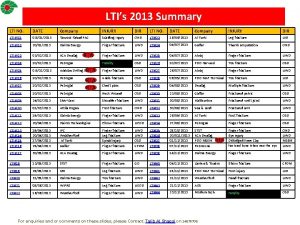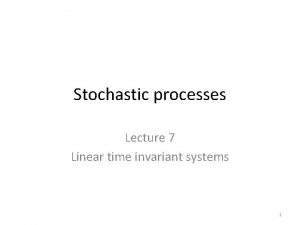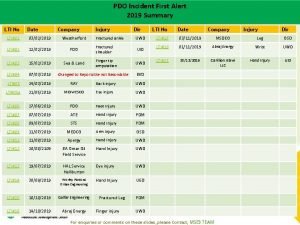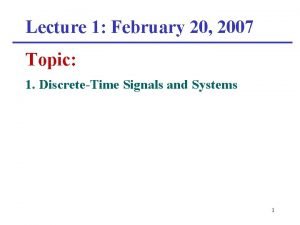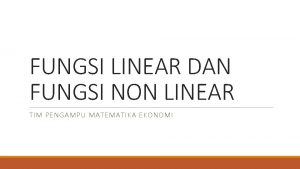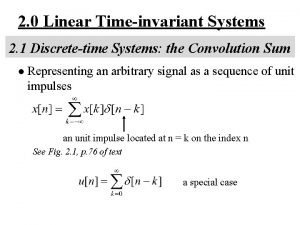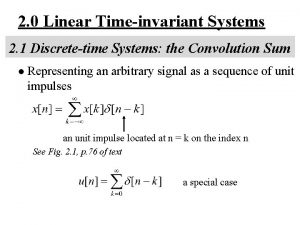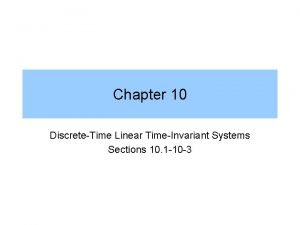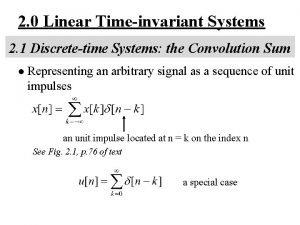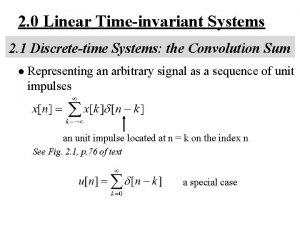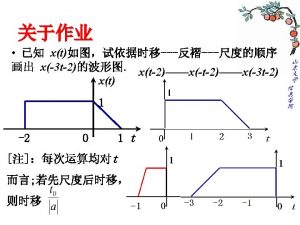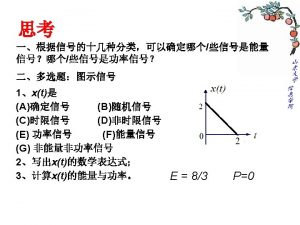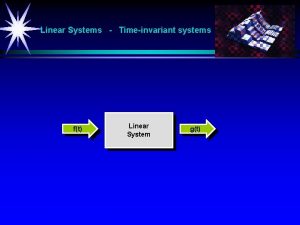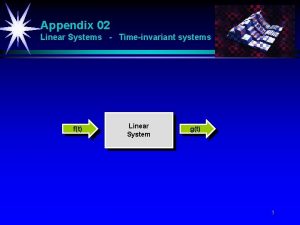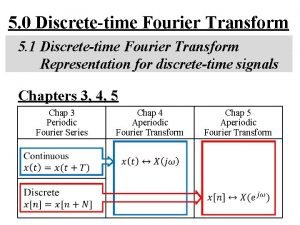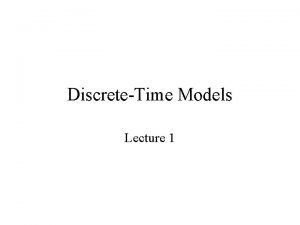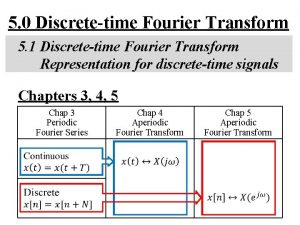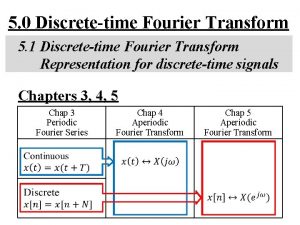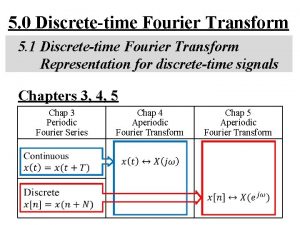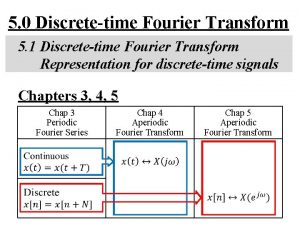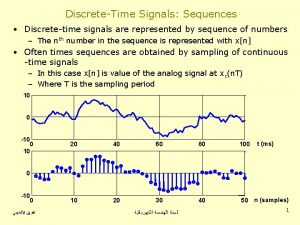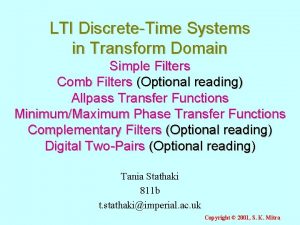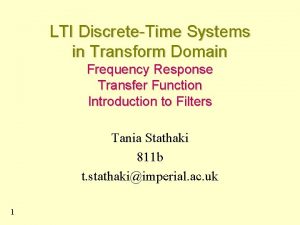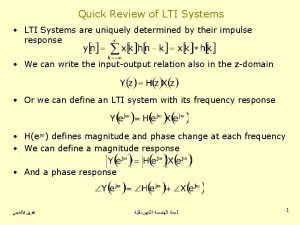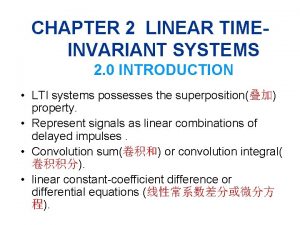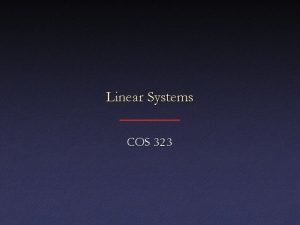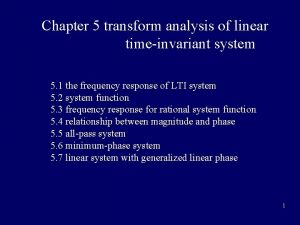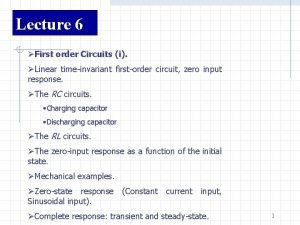2 Linear TimeInvariant Systems 2 1 Discretetime LTI



![2 Linear Time-Invariant Systems (2) Convolution Sum of LTI System Question: x[n] LTI y[n]=? 2 Linear Time-Invariant Systems (2) Convolution Sum of LTI System Question: x[n] LTI y[n]=?](https://slidetodoc.com/presentation_image_h2/64aaab0ebcd8ce179fc0859f42f569b3/image-4.jpg)


![2 Linear Time-Invariant Systems So ( Convolution Sum ) or y[n] = x[n] * 2 Linear Time-Invariant Systems So ( Convolution Sum ) or y[n] = x[n] *](https://slidetodoc.com/presentation_image_h2/64aaab0ebcd8ce179fc0859f42f569b3/image-7.jpg)









![2 Linear Time-Invariant Systems 2. 3. 1 The Commutative Property Discrete time: x[n]*h[n]=h[n]*x[n] Continuous 2 Linear Time-Invariant Systems 2. 3. 1 The Commutative Property Discrete time: x[n]*h[n]=h[n]*x[n] Continuous](https://slidetodoc.com/presentation_image_h2/64aaab0ebcd8ce179fc0859f42f569b3/image-17.jpg)
![2 Linear Time-Invariant Systems 2. 3. 2 The Distributive Property Discrete time: x[n]*{h 1[n]+h 2 Linear Time-Invariant Systems 2. 3. 2 The Distributive Property Discrete time: x[n]*{h 1[n]+h](https://slidetodoc.com/presentation_image_h2/64aaab0ebcd8ce179fc0859f42f569b3/image-18.jpg)
![2 Linear Time-Invariant Systems 2. 3. 3 The Associative Property Discrete time: x[n]*{h 1[n]*h 2 Linear Time-Invariant Systems 2. 3. 3 The Associative Property Discrete time: x[n]*{h 1[n]*h](https://slidetodoc.com/presentation_image_h2/64aaab0ebcd8ce179fc0859f42f569b3/image-19.jpg)











![2 Linear Time-Invariant Systems Example: y[n]+ay[n-1]=bx[n] 2 Linear Time-Invariant Systems Example: y[n]+ay[n-1]=bx[n]](https://slidetodoc.com/presentation_image_h2/64aaab0ebcd8ce179fc0859f42f569b3/image-31.jpg)





- Slides: 36

2 Linear Time-Invariant Systems 2. 1 Discrete-time LTI system: The convolution sum 2. 1. 1 The Representation of Discrete-time Signals in Terms of Impulses If x[n]=u[n], then

2 Linear Time-Invariant Systems

2 Linear Time-Invariant Systems 2. 1. 2 The Discrete-time Unit Impulse Response and the Convolution Sum Representation of LTI Systems (1) Unit Impulse(Sample) Response x[n]= [n] LTI y[n]=h[n] Unit Impulse Response: h[n]
![2 Linear TimeInvariant Systems 2 Convolution Sum of LTI System Question xn LTI yn 2 Linear Time-Invariant Systems (2) Convolution Sum of LTI System Question: x[n] LTI y[n]=?](https://slidetodoc.com/presentation_image_h2/64aaab0ebcd8ce179fc0859f42f569b3/image-4.jpg)
2 Linear Time-Invariant Systems (2) Convolution Sum of LTI System Question: x[n] LTI y[n]=? Solution: [n] h[n] [n-k] h[n-k] x[k] [n-k] x[k] h[n-k]

2 Linear Time-Invariant Systems

2 Linear Time-Invariant Systems
![2 Linear TimeInvariant Systems So Convolution Sum or yn xn 2 Linear Time-Invariant Systems So ( Convolution Sum ) or y[n] = x[n] *](https://slidetodoc.com/presentation_image_h2/64aaab0ebcd8ce179fc0859f42f569b3/image-7.jpg)
2 Linear Time-Invariant Systems So ( Convolution Sum ) or y[n] = x[n] * h[n] (3) Calculation of Convolution Sum Time Inversal: h[k] h[-k] Time Shift: h[-k] h[n-k] Multiplication: x[k]h[n-k] Summing: Example 2. 1 2. 2 2. 3 2. 4 2. 5

2 Linear Time-Invariant Systems 2. 2 Continuous-time LTI system: The convolution integral 2. 2. 1 The Representation of Continuous-time Signals in Terms of Impulses Define We have the expression: Therefore:

2 Linear Time-Invariant Systems

2 Linear Time-Invariant Systems or

2 Linear Time-Invariant Systems 2. 2. 2 The Continuous-time Unit impulse Response and the convolution Integral Representation of LTI Systems (1) Unit Impulse Response x(t)= (t) LTI y(t)=h(t) (2) The Convolution of LTI System x(t) LTI y(t)=?

2 Linear Time-Invariant Systems (t) A. LTI x(t) h(t) y(t)=? Because of So, we can get ( Convolution Integral ) or y(t) = x(t) * h(t)

2 Linear Time-Invariant Systems B. (t) LTI or y(t) = x(t) * h(t) h (t) ( Convolution Integral )

2 Linear Time-Invariant Systems

2 Linear Time-Invariant Systems (3) Computation of Convolution Integral Time Inversal: h( ) h(- ) Time Shift: h(- ) h(t- ) Multiplication: x( )h(t- ) Integrating: Example 2. 6 2. 8

2 Linear Time-Invariant Systems 2. 3 Properties of Linear Time Invariant System Convolution formula: x(t) x[n] h(t) h[n] y(t)=x(t)*h(t) y[n]=x[n]*h[n]
![2 Linear TimeInvariant Systems 2 3 1 The Commutative Property Discrete time xnhnhnxn Continuous 2 Linear Time-Invariant Systems 2. 3. 1 The Commutative Property Discrete time: x[n]*h[n]=h[n]*x[n] Continuous](https://slidetodoc.com/presentation_image_h2/64aaab0ebcd8ce179fc0859f42f569b3/image-17.jpg)
2 Linear Time-Invariant Systems 2. 3. 1 The Commutative Property Discrete time: x[n]*h[n]=h[n]*x[n] Continuous time: x(t)*h(t)=h(t)*x(t) h(t) x(t) y(t)=x(t)*h(t) y(t)=h(t)*x(t)
![2 Linear TimeInvariant Systems 2 3 2 The Distributive Property Discrete time xnh 1nh 2 Linear Time-Invariant Systems 2. 3. 2 The Distributive Property Discrete time: x[n]*{h 1[n]+h](https://slidetodoc.com/presentation_image_h2/64aaab0ebcd8ce179fc0859f42f569b3/image-18.jpg)
2 Linear Time-Invariant Systems 2. 3. 2 The Distributive Property Discrete time: x[n]*{h 1[n]+h 2[n]}=x[n]*h 1[n]+x[n]*h 2[n] Continuous time: x(t)*{h 1(t)+h 2(t)}=x(t)*h 1(t)+x(t)*h 2(t) x(t) Example 2. 10 h 1(t)+h 2(t) h 1(t) h 2(t) y(t)=x(t)*{h 1(t)+h 2(t)} y(t)=x(t)*h 1(t)+x(t)*h 2(t)
![2 Linear TimeInvariant Systems 2 3 3 The Associative Property Discrete time xnh 1nh 2 Linear Time-Invariant Systems 2. 3. 3 The Associative Property Discrete time: x[n]*{h 1[n]*h](https://slidetodoc.com/presentation_image_h2/64aaab0ebcd8ce179fc0859f42f569b3/image-19.jpg)
2 Linear Time-Invariant Systems 2. 3. 3 The Associative Property Discrete time: x[n]*{h 1[n]*h 2[n]}={x[n]*h 1[n]}*h 2[n] Continuous time: x(t)*{h 1(t)*h 2(t)}={x(t)*h 1(t)}*h 2(t) x(t) h 1(t)*h 2(t) h 1(t) y(t)=x(t)*{h 1(t)*h 2(t)} h 2(t) y(t)=x(t)*h 1(t)*h 2(t)

2 Linear Time-Invariant Systems 2. 3. 4 LTI system with and without Memoryless system: Discrete time: y[n]=kx[n], h[n]=k [n] Continuous time: y(t)=kx(t), h(t)=k (t) x[n] k (t) k [n] y(t)=kx(t)=x(t)*k (t) y[n]=kx[n]=x[n]*k [n] Imply that: x(t)* (t)=x(t) and x[n]* [n]=x[n]

2 Linear Time-Invariant Systems 2. 3. 5 Invertibility of LTI system Original system: h(t) Reverse system: h 1(t) x(t) x(t)* (t)=x(t) So, for the invertible system: h(t)*h 1(t)= (t) or h[n]*h 1[n]= [n] Example 2. 11 2. 12

2 Linear Time-Invariant Systems 2. 3. 6 Causality for LTI system Discrete time system satisfy the condition: h[n]=0 for n<0 Continuous time system satisfy the condition: h(t)=0 for t<0

2 Linear Time-Invariant Systems 2. 3. 7 Stability for LTI system Definition of stability: Every bounded input produces a bounded output. Discrete time system: If |x[n]|<B, the condition for |y[n]|<A is

2 Linear Time-Invariant Systems Continuous time system: If |x(t)|<B, the condition for |y(t)|<A is Example 2. 13

2 Linear Time-Invariant Systems 2. 3. 8 The Unit Step Response of LTI system Discrete time system: [n] u[n] h[n] s[n]=u[n]*h[n] Continuous time system: (t) u(t) h(t) s(t)=u(t)*h(t)

2 Linear Time-Invariant Systems 2. 4 Causal LTI Systems Described by Differential and Difference Equation Discrete time system: Differential Equation Continuous time system: Difference Equation

2 Linear Time-Invariant Systems 2. 4. 1 Linear Constant-Coefficient Differential Equation A general Nth-order linear constant-coefficient differential equation: or and initial condition: y(t 0), y’(t 0), …… , y(N-1)(t 0) ( N values )

2 Linear Time-Invariant Systems 2. 4. 2 Linear Constant-Coefficient Difference Equation A general Nth-order linear constant-coefficient difference equation: or and initial condition: y[0], y[-1], …… , y[-(N-1)] ( N values ) Example 2. 15

2 Linear Time-Invariant Systems 2. 4. 3 Block Diagram Representations of First-order Systems Described by Differential and Difference Equation (1) Dicrete time system Basic elements: A. An adder B. Multiplication by a coefficient C. An unit delay

2 Linear Time-Invariant Systems Basic elements:
![2 Linear TimeInvariant Systems Example ynayn1bxn 2 Linear Time-Invariant Systems Example: y[n]+ay[n-1]=bx[n]](https://slidetodoc.com/presentation_image_h2/64aaab0ebcd8ce179fc0859f42f569b3/image-31.jpg)
2 Linear Time-Invariant Systems Example: y[n]+ay[n-1]=bx[n]

2 Linear Time-Invariant Systems (2) Continuous time system Basic elements: A. An adder B. Multiplication by a coefficient C. An (differentiator) integrator

2 Linear Time-Invariant Systems Basic elements:

2 Linear Time-Invariant Systems Example: y’(t)+ay(t)=bx(t)

2 Linear Time-Invariant Systems 2. 5 Singularity Functions 2. 5. 1 The unit impulse as idealized short pulse (1) (2)

2 Linear Time-Invariant Systems Several important formula: Problems: 2. 1 2. 3 2. 5 2. 18 2. 19 2. 20 2. 7 2. 10 2. 11 2. 12 2. 23 2. 24 2. 40 2. 47
 Last lti in pdo 2022
Last lti in pdo 2022 Pdo last lti
Pdo last lti Ct lti system
Ct lti system Commutative property of lti system
Commutative property of lti system Xv-lti 026
Xv-lti 026 Lti
Lti Lti
Lti Sistem lti
Sistem lti Lti pdo
Lti pdo Pdo lti
Pdo lti Pdo lti
Pdo lti Lti pdo
Lti pdo Lti pdo
Lti pdo Impulse response of lti system examples
Impulse response of lti system examples Lti hse
Lti hse California lti training
California lti training Lti belfast
Lti belfast Pdo lti
Pdo lti Pdo lti
Pdo lti Pdo lti
Pdo lti Pdo lti
Pdo lti Lti hse
Lti hse Pdo lti
Pdo lti Pdo lti
Pdo lti Pdo lti 2020
Pdo lti 2020 Lti hse
Lti hse Pengertian lti
Pengertian lti Simple multiple linear regression
Simple multiple linear regression Contoh soal metode numerik biseksi dan penyelesaiannya
Contoh soal metode numerik biseksi dan penyelesaiannya Linear vs nonlinear text
Linear vs nonlinear text Definition of linear plot in literature
Definition of linear plot in literature Contoh soal dan penyelesaian metode iterasi gauss -seidel
Contoh soal dan penyelesaian metode iterasi gauss -seidel Linear pipeline in computer architecture
Linear pipeline in computer architecture Linear and nonlinear
Linear and nonlinear Linear grammar
Linear grammar Fungsi linear dan non linear
Fungsi linear dan non linear Fungsi non
Fungsi non




